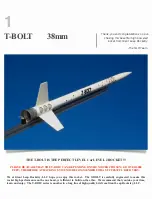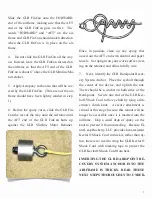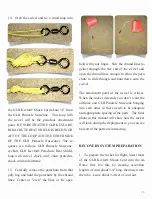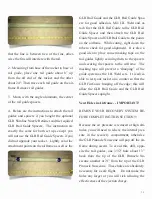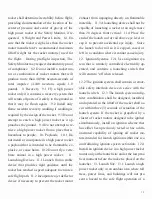
that the line is between two of the fins, other-
wise the fins will interfere with the rail.
2. Measuring from base of the rocket to base of
rail guide, place one rail guide about 8” up
from the aft end of the rocket and the other
about 24". Then trace each rail guide on the air-
frame. Remove rail guides.
3. Mark, with the angle aluminum, the center
of the rail guide spacers.
4. Below are the instructions to attach the rail
guides and spacers if you bought the optional
GLR Slimline Nozzle Retainer and the required
GLR Rail Guide Spacers. The instruction are
exactly the same for both set ups except you
will not use the GLR Rail Guide Spacers if you
did not upgrade your rocket. Lightly sand the
attachment points on the airframe as well as the
GLR Rail Guide and the GLR Rail Guide Spac-
ers for good adhesion. Mix J.B. Weld and at-
tach first the GLR Rail Guide to the GLR Rail
Guide Spacer and then attach the GLR Rail
Guide Spacer and GLR Rail Guide to the points
on the airframe. While curing, sight down the
tube to check for good alignment. It is also a
good idea to place some masking tape on the
rail guides lightly securing them to the spacers
and securing the spacers to the airframe. The
masking tape will prevent a “drooping” of the
guide system as the J.B. Weld sets. It is advis-
able to rest your rocket on a counter so that the
GLR FinCan is hanging off the edge; this will
allow the GLR Rail Guide and the GLR Rail
Guide Spacers upright.
Vent Holes in Airframe - - IMPORTANT!
REMOVE YOUR RECOVERY SYSTEM BE-
FORE COMPLETING THIS SECTION!!!
Because the air pressure is reduced at high alti-
tudes, you will need to relieve the internal pres-
sure in the recovery compartment; otherwise
the GLR Pinnacle Nosecone will pop off the air-
frame during ascent. To avoid this, drill, oppo-
site the rail guides, one 3/32” hole about 13”
back from the tip of the GLR Pinnacle No-
secone, another at 21” from the tip of the GLR
Pinnacle Nosecone. These holes are absolutely
necessary for a safe flight. Do not make the
holes any larger or you will risk reducing the
effectiveness of the ejection charge.
12


